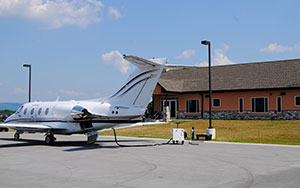
Winchester Municipal Airport
May 5, 2016
Tennessee’s Winchester Municipal Airport (BGF) has seen steady growth since its humble beginnings in 1968, and today is a valuable asset to the community, said airport manager Zachary Colescott.
“I’ve seen it time and time again said that businesspeople arrive on an aircraft at the airport, not in a car, and that has certainly been true here,” he said. “Two of the largest employers in the area have flat-out said that if it weren’t for a well-functioning airport being here, they wouldn’t have located their companies here.”
For example, Nissan North America, which is based near the airport, began utilizing BGF to bring employees to their powertrain facility site, and as buildings went up and production started, passenger traffic gave way to freight operations. Suppliers and vendors also fly in to visit the manufacturing facility as well, to conduct their own business.
The airport has grown from a small field supporting a handful of single-engine aircraft into one that bases 41 aircraft, including several multi and turbine-powered aircraft, Colescott said. It now boasts a 5,000-foot long runway with a full-length parallel taxiway, clear GPS approaches to both ends with 400’ minimums, a new terminal building, energy efficient LED airfield lighting, and the capability to handle most small- to medium- sized business aircraft.
On average, the airport services about 15 to 20 aircraft per day, but on a busy weekend, it could service more than 100 aircraft.

“Rapidly, the airport went from an entity that was directly responsible for employing three to five people to one that housed the jobs of 40-plus people,” he said. “Those people brought families with them to the area that also have integrated into the community, buying goods and services and also needing employment.
“Many times local businesses may not know the airport is benefitting them, but the ripples can certainly be felt throughout the local economy,” he added.
Colescott recently requested copies of the No Plane No Gain Business Aviation Fact Book to share with local officials.
“I would hope that our local officials do know what an asset the airport is, but it never hurts to remind them,” he said. “Big and small businesses recognize the advantages that general aviation can bring to them, and they certainly take notice when that asset is missing within a community.”
As far as people in the local community are concerned, Colescott said they are proud of the airport, but don’t always have a grasp on what an asset it is to them. The local chapter of the Experimental Aircraft Association hosts a fly-in breakfast every month, which has started to draw not only those flying in, but also local citizens coming out to learn more about general aviation and the airport.
“Airports represent opportunity in the community,” he said. “If you want to attract those businesses bringing 2,000 jobs, you better be ready to pick them up at the local airport. Invest in your local airport and it will pay off in dividends.”
